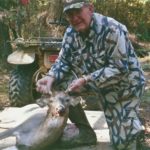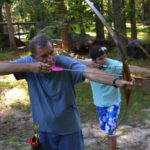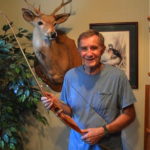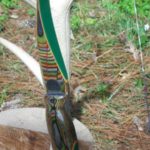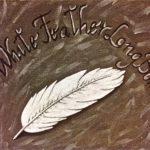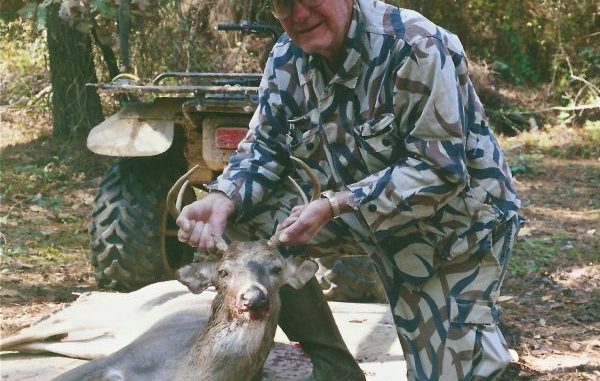
A boyhood passion for longbows took over this man’s life. Learn how he uses this truly primitive weapon to hunt deer — and how he’s passing along his love to a new generation of hunters.
Like most of his young friends decades ago, Gary Pat Craig went to the Saturday afternoon movies at the Don Theater in Alexandria to watch popular shoot-em-up Westerns.
But Craig often found himself pulling for the Indians instead of the Cowboys. Why? He was fascinated with their weapon of choice — the longbow.
Now 73 years old, while 95 percent or more of America’s bowhunters are addicted to intricate and expensive compound bows, he remains fascinated with the longbow.
In fact, that fascination has become what he calls “a hobby gone wild.” He’s done just about everything in the bow world from hunting to teaching others to making his own bows.
Bowhunting is a fast-growing sport. The Archery Trade Association estimates there are 14 million male archers and 6 million female archers in America today.
Craig, a retired businessman in Pineville, not only hunts with longbows, he also makes them. Lots of them. It has become a passion over the years.
And fortunately for dozens of young shooters, he is also passionate about helping them: He has made hundreds of bows for kids and given many of them to those who couldn’t afford to pay for the bows.
“I have shot bows and bowhunted all my life,” Craig said. “I have had a passion for bows since I can remember. I grew up shooting a $15 longbow that I got at the old Johnny Rushing Sporting Goods store in Alexandria.
“And that wasn’t a cheap bow in those days. And, yes, that story about rooting for the Indians is true.”
Craigt didn’t have the luxury of someone to teach him, but that didn’t stop him. He found a few movies of Fred Bear and learned from them.
Then, when he was in high school, the legendary Ben Pearson came to Bolton High and performed shooting tricks to promote archery. Person bounced ping-pong balls across the floor and shot them with his bow and arrow.
Craig was nocked for life.
Everyone didn’t share in his passion, though. His father kept telling him to put that ”toy” up and do something productive.
After a lengthy argument, Craig’s dad issued a challenge: He put a mark on a pear tree in the yard and told Craig to hit it.
The young archer did. And he put the arrow deep into the tree, proving his bow was no toy.
And that he was good enough to take the bow hunting.
In the 1950s, Craig learned even found a couple of friends to share that passion with. He recalls in the early days that he had to carry a state hunting brochure to prove to a couple of local game wardens that it was actually legal to hunt deer with a bow.
Obviously, a lot has changed since then.
Craig’s shooting ability in archery tournaments, his hunting prowess with a bow and his love for the sport took him where not many men go — he became a bowyer.
A bowyer is simply someone who makes bows. He started out with longbows or recurve bows, but went the same direction as others when the compound bows started coming out.
But after a few years, he returned to his original passion.
“I realized I could do anything with a longbow that I could do with a compund bow, and the longbow was a lot less trouble,” Craig said. “We started off real plain, built a couple and started refining the program until we got a bow that would shoot as good as any bow of any type.
“I had a friend who owned a cabinet company, and he would give me scraps of wood to get started. I needed it at least 1 ½ inches wide, and he had plenty. He had walnut and hard maple and wood like that; he couldn’t use it, but it was perfect for me. That’s what we started out with.”
Later he found an alternative.
“Then I found a supply of inexpensive fiberglass seconds that I used,” Craig explained. “It had some streaks in it, but that doesn’t have any affect on the way a bow shoots.”
Proficiency with his weapon of choice isn’t something that comes quickly, he said.
“Learning to hunt with a bow and arrow takes a lot of patience and skill,” Craig said. “The No. 1 thing before you even think about going to the woods is to master shooting the bow.
“Accuracy is everything — consistent accuracy. That comes with practice, and good equipment. Not fancy equipment, just good equipment.”
Second on the list is learning the area you are going to hunt and finding deer sign.
Obviously, with a bow and arrow you can’t just get in a box stand on the edge of a pipeline: You have to get in the woods where the deer are.
And get close.
“Where we hunt near Winnfield, there are a lot of cutovers, so you have to find where the deer are traveling,” Craig said. “You find the trails and find where the deer are going from their bedding areas to their feed areas.
“It takes time, just like learning to shoot a bow.”
Because there aren’t an abundance of big trees in the woods he hunts, Craig has learned to hunt in ground blinds most of the time.
He also said that, at his age, it is a smart move as well as an effective one. Climbing 30 feet in a tree isn’t a good move.
“Some people may disagree, but I tell you: If you watch the deer, you’ll see them looking up in the trees during the season as much as on the ground,” Craig said. “They know that hunters are up there.
“That old line about ‘deer never look up,’ well, that isn’t true anymore.”
Craig also uses trail cameras to help make sure he’s on active trails, and that also gives him an idea of when the deer are moving.
And it works. Well, most of the time.
“I’ve got this one great, big old buck that I’ve been hunting three years now,” Craig said. “He keeps getting bigger and I keep getting outstmarted.
“I see him regularly on the camera, but during the season, he totally goes nocturnal. The only time I’ve even gotten a picture of him on the trail camera during the day was Christmas morning of last year. Christmas morning at 9 a.m., he comes down the trail, stops right at the trail camera and seems to pose — first on one side, then turns to the other like, ‘Is this my best side?’
“I’m not kidding. How did he know it was Christmas morning and I wouldn’t be there? That isn’t right.”
The other most-important tip when bowhunting is to watch the wind. When you are getting 10, 20, 30 yards from a deer, you better be where the animal can’t smell you or see you.
Craig’s legacy as one of the last of the longbow lovers will be hard to surpass. And it will be known well beyond just his immediate family and those he has taught to shoot.
That’s because Craig spends any available spare time helping teach bow hunting at the local Camp Hardtner and giving lessons to young people.
One of his favorite students is his grandson, Sean Craig Jr., who won a bronze medal at the recent 4-H Shooting Sports National Championships.
The young Craig was the only one there shooting a longbow instead of the Olympic style recurve bow with a sight. But he won the competition with a bow he made himself, with close supervision from his grandfather.
“It’s exciting to see young people taking up the sport,” the elder Craig said. “I find myself now making all different-color bows for kids, but the one most in demand is the pink one.
“And that’s just fine with me. The girls are learning to shoot just as well as the boys.”
Craig’s must-have equipment
The first item that bowyer Gary Pat Craig puts on his must-have bowhunting list might surprise people.
But it shouldn’t.
“One of the best inventions for deer hunters in Louisiana that they’ve ever come up with is the ThermaCell,” Craig said. “With our mosquitoes, you can’t stay in the woods around here without one. And, unlike regular repellent, the deer can’t smell this.”
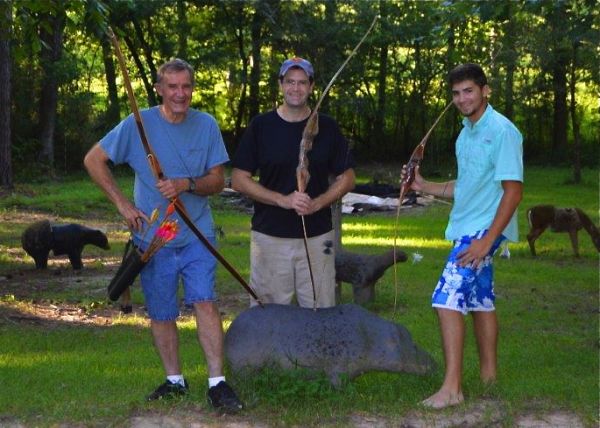 Next on his list is a good camouflaged ground blind — one that blends in with your surroundings, allows you to change positions with the wind and gives you room to move around without scaring the deer.
Next on his list is a good camouflaged ground blind — one that blends in with your surroundings, allows you to change positions with the wind and gives you room to move around without scaring the deer.
Dozens of good choices are available.
He said if you have more than one bow, it’s important to choose the one you’re most-comfortable using.
“I have more bows than the average small sporting goods store, but when I head to the woods I almost always grab my favorite 64-inch, 42-pound longbow that I made from zebrawood and bamboo,” Craig said.
His favorite arrows are the simple Mangus two-blade models.
Because of the thick areas he hunts, he also depends on a pair of Under Armour Brow Tine hunting boots.
Other items on Craig’s list:
- A “sit and drag” sling seat
- A compass
- A flashlight
- A lighter
- A camo face net
- A small water bottle
- A couple of energy bars
- A good pair of light gloves.
- Scent killer
Last but not least, Craig said a good scent killer is a must.
But because he hunts a lot and commercial scent killer can be expensive, he and a friend found a recipe and make their own by the gallon. Check out how they do it elsewhere in this article.
How to make your own scent killer
On the Beverly Hillbillies, Granny never would share her recipe for moonshine.
But Gary Pat Craig doesn’t mind sharing how he makes a homemade brew to cover his scent while deer hunting.
“It’s not original, but it works. It’s a killer,” Craig said. “And it’s much more economical than the store-bought stuff — especially when you hunt deer as often as I do.”
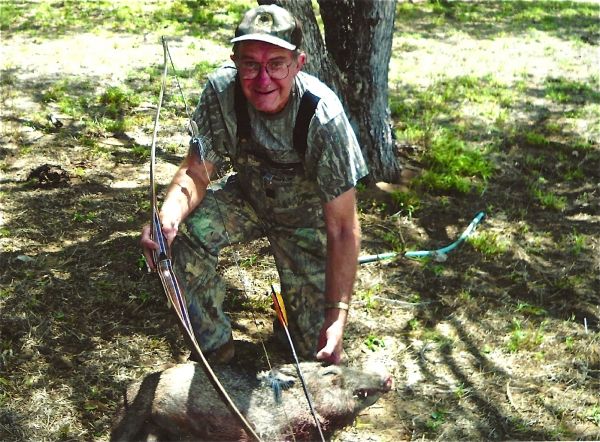 Craig starts with a gallon bottle and 16 ounces (2 cups) of distilled water. He then adds 2 cups of 3 percent peroxide that you can find at a pool supply store or some hardware outlets.
Craig starts with a gallon bottle and 16 ounces (2 cups) of distilled water. He then adds 2 cups of 3 percent peroxide that you can find at a pool supply store or some hardware outlets.
He then add ¼ cup of baking soda and an ounce of non-scented shampoo.
Shake it up good and put it in a spray bottle. Use liberally right before you go into the woods.
